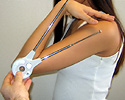Study finds overweight children have less elbow range of motion

Children who are overweight have less range of motion in their elbows than their normal-weight peers, which could make it tougher for them to exercise in order to lose weight, the findings of a research study suggest.
“Overweight children are encouraged to participate in sports. But athletic activities like pitching or hitting a baseball or shooting a free-throw in basketball require full elbow range of motion,” said senior study author Melvin Heyman, MD.
“The results of our study suggest that overweight children may have difficulty participating in the same athletic endeavors as their normal-weight counterparts due to decreased joint motion. This could make it more difficult to lose weight and might further discourage overweight children from participation in sports,” said Heyman, a professor of pediatrics and chief of pediatric gastroenterology and nutrition at UCSF Children’s Hospital.
The study is published in the February edition of the “Journal of Pediatric Gastroenterology and Nutrition.”
Children and adolescents in the US are known to be less active today than at any other time in history, and less active children are more likely to be overweight. Children are considered overweight if their body mass index (BMI) is at or above the 95th percentile for their age and sex. Children who are at risk of overweight have a BMI between the 85th and 95th percentiles. BMI is calculated by dividing a person’s weight in kilograms by height in meters squared.
For example, a 10-year-old boy who is 142 centimeters tall (four-foot, eight-inches) and weighs 33 kilograms (73 pounds) would be average weight, with a BMI at the 50th percentile. If he weighed 45 kilograms (99 pounds) he would have a BMI in the 95th percentile and would be overweight. An estimated 15 percent of all American children from 6 to 11 years old and 15 percent of 12 to 19 year olds have a BMI at or above the 95th percentile on standard growth charts, according to the US Centers for Disease Control and Prevention.
Childhood overweight has reached epidemic proportions in the US and other developed countries and has been associated with eating disorders, hypertension, sleep disorders, atherosclerosis and an increased risk of early-onset type 2 diabetes, according to Heyman. It has also been associated with adverse psychosocial consequences, including lowered self-esteem and depression. Overweight children are also more likely to be victims or perpetrators of bullying than are their normal-weight peers, he added.
The study correlated the elbow range of motion and BMIs of 113 healthy children between the ages of 2 and 18 who were recruited from a Chicago pediatric orthopedic clinic in 2004. Sixty five percent of participants were male. Children with a history of previous trauma or disease of the elbows were excluded. Seventy two of the participants had weights in the normal range, with BMIs in the 15th to 85th percentile. Fifteen participants were at risk of being overweight, with BMIs from the 85th to 95th percentile, and 20 were overweight, with BMIs at or above the 95th percentile. Six were underweight, with BMIs below the 15th percentile.
Researchers measured elbow range of motion using a standard orthopedic instrument called an extendable goniometer. The device is a hinge with two slender metal arms attached. To measure range of motion, the hinge is positioned at the elbow joint, with one arm extended along the length of the forearm and the other along the upper arm. The arms of the device follow the subjects’ motions as they flex and a gauge on the fulcrum calculates range of motion in degrees.
The study found a clear correlation between increased BMI and decreased range of motion. When BMI is one standard deviation above normal, a child loses approximately two to three degrees of elbow movement. But the elbow of a child who is in the 99th percentile will flex between 12 to 15 degrees less than normal-weight peers. This loss of elbow movement may have significant effects on the overweight child’s ability to participate in athletics, the study’s authors say.
Study lead author Daniel Golden, MD, who was a medical student at the University of Illinois, Chicago School of Medicine when the research was conducted, is now an intern at the Kaiser Permanente Medical Center in Oakland, CA. He said the reason for the difference in elbow range of motion may be increased “soft tissue mass,” or fat, that may “interfere with complete flexion of the elbow joint in children with larger BMIs.”
“Further research is needed to determine whether the loss of range of motion found in our study is significant on a baseball diamond, basketball court, or football field,” Golden said. “It may be that there are particular sports that are more conducive to successful participation by overweight children than others.”
Study researchers include Janet M. Wojcicki, MD, of UCSF; Jeffrey T. Jhee, MD, and Susan L. Gilpin, MD, of Rush University Medical Center; and Jeffrey R. Sawyer, MD, of the University of Tennessee-Campbell Clinic. The study was supported in part by a grant from the National Institutes of Health.
One of the nation’s top children’s hospitals, UCSF Children’s Hospital creates an environment where children and their families find compassionate care at the healing edge of scientific discovery, with more than 150 experts in 50 medical specialties serving patients throughout Northern California and beyond. The hospital admits about 5,000 children each year, including 1,600 babies born there.
## Image Available:
An image of an extendable goniometer for measuring elbow range of motion is available at
http://www.ucsf.edu/media/images/imagedb/021105a.jpg
.